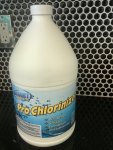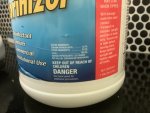- Nov 28, 2020
- 253
- Pool Size
- 15600
- Surface
- Plaster
- Chlorine
- Salt Water Generator
- SWG Type
- CircuPool RJ-45 Plus
First off, I paid for a premium subscription for the Pool Math app. Then I logged into the app with my TFP forum credentials. Now it says to subscribe for unlimited test logs. I am assuming the one premium subscription will be good for all my devices? How do I sync them so I have the premium subscription linked to my TFP account, and on multiple devices?
Now, I used my Taylor K-2006 for the first time today and this is what I came up with:
FC 7.8
CC .04
PH 7.5
TA 140
CH 360
CYA 84
Borate 20 (from test strip)
Pool Math is recommending a significantly higher chlorine level due to the high CYA, and my borate is very low. So I am thinking the first things I should do is lower the CYA significantly through partial draining and refilling, then bring the borate level up and balance the expected Ph swing, then re-test the water and get alkalitinity in line, then balance the chlorine. Does that sound like a good plan? Also I think my water is already hard but within ok range, but Pool Math is telling me to add calcium chloride to make it harder, if I am not mistaken. Not sure if I should do that.
FYI, from a water test from the pool store two days ago (I had almost zero chlorine at the time) it showed:
hardness 231
TA (w/stabilizer correction) 86
CYA 87
copper .1 ppm
iron .2 ppm
borate 15 ppm
My pool is plaster/chlorine 11.7x40 ft avg. depth 4.5 and calculated 15,600 gallons. Also here is a read only link to a google spreadsheet I started today with test results: Pool Maintenance Murlesan
Thanks in advance for the guidance.
Now, I used my Taylor K-2006 for the first time today and this is what I came up with:
FC 7.8
CC .04
PH 7.5
TA 140
CH 360
CYA 84
Borate 20 (from test strip)
Pool Math is recommending a significantly higher chlorine level due to the high CYA, and my borate is very low. So I am thinking the first things I should do is lower the CYA significantly through partial draining and refilling, then bring the borate level up and balance the expected Ph swing, then re-test the water and get alkalitinity in line, then balance the chlorine. Does that sound like a good plan? Also I think my water is already hard but within ok range, but Pool Math is telling me to add calcium chloride to make it harder, if I am not mistaken. Not sure if I should do that.
FYI, from a water test from the pool store two days ago (I had almost zero chlorine at the time) it showed:
hardness 231
TA (w/stabilizer correction) 86
CYA 87
copper .1 ppm
iron .2 ppm
borate 15 ppm
My pool is plaster/chlorine 11.7x40 ft avg. depth 4.5 and calculated 15,600 gallons. Also here is a read only link to a google spreadsheet I started today with test results: Pool Maintenance Murlesan
Thanks in advance for the guidance.
Last edited:






